Computer-aided design (CAD) software was developed as part of a project delivered in 1960 by MIT’s Electronic Systems Laboratory, in collaboration with the United States Air Force.
The technical memorandum of the project states, “The objective of the Computer-Aided Design Project is to evolve a man-machine system which will permit the human designer and the computer to work together on creative design problems.”
The state of CAD software
While tech and the tech industry have both evolved tremendously since 1960, the objective of CAD has remained the same. In more than half a century since CAD's inception, some products have evolved into product lifecycle management (PLM) software; others are still focusing on design. At the same time, there are many 3D design tools that can be a good alternative to CAD software for companies with basic product development needs or freelancers.
Despite the alternatives, CAD software maintains a critical role in the design strategy of companies from multiple industries like manufacturing, construction, civil engineering, and more. To understand how CAD software is evolving, we analyzed more than 2,000 reviews of general-purpose CAD software users. These reviews were submitted between February 2013 and May 2020.
The reviewers were majorly CAD users (82%) and system administrators (6%). Almost half (48%) of the reviewers came from small businesses, with 32% belonging to mid-market companies and 20% to enterprise businesses. Of the 110 industries mentioned by users, the most frequent were architecture and planning (27%), civil engineering (16%), design (15%), and mechanical or industrial engineering (10%). Most users had significant experience using CAD software: 34% mentioned 5 years or more of experience.
The image below provides an overview of the respondents by role, company size, and level of experience.
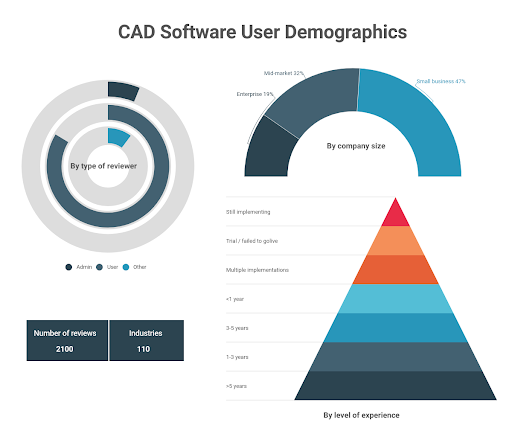
What reviewers think about CAD
Each reviewer provided feedback on multiple questions on satisfaction, pricing, ROI, adoption, and so on. Upon analysing the product reviews, the overall consensus is that CAD software is headed in the right direction, mentioned by 80% of reviewers.
To better understand what users think about CAD, we compiled their answers and analyzed them by criteria (simple six*, ROI, pricing, and so on), and by company size or industry.
*The simple six are the six questions asked of every user who leaves a product review. These questions include: does the product meet requirements, what’s the ease of use, ease of setup, ease of admin, quality of support, and ease of doing business with. These products are ranked on a scale of 1-7 with 7 being the most satisfied and 1 being the least satisfied.
How are users rating their CAD systems?
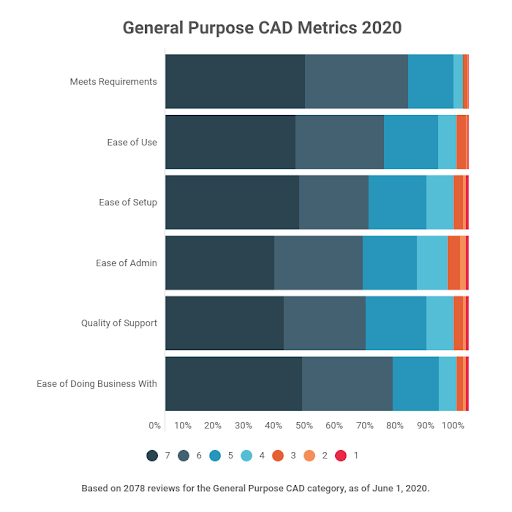
Across the board, users are very satisfied with their CAD systems. From ease of setup to ease of use, general-purpose CAD vendors seem to consistently please customers with products that are intuitive and offer a wide range of functionality.
CAD vendors not only provide systems that are easy to use and simple to implement, but they also present users with a wide range of how-to tutorials and discussion communities so they can better understand how to fully utilize their products. Various users in the general-purpose CAD space highlight this as an essential feature in our G2 review data:
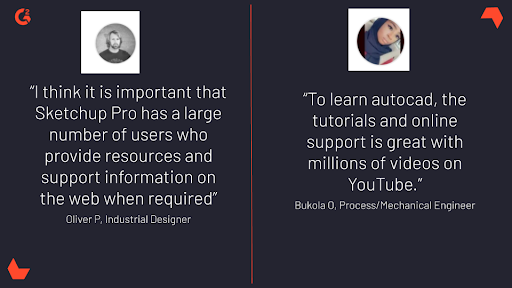
What do users think of their CAD system’s value?
A majority of CAD software in the marketplace is expensive. While some CAD vendors offer annual subscriptions in the average range of $1,500-$3,000, there are also systems that come as one-time purchases at a price tag of $12,000.
On a positive note, most CAD users who purchase general-purpose CAD software see their return on investment (ROI) in 1 year, and 41% of users even notice so in less than 6 months.
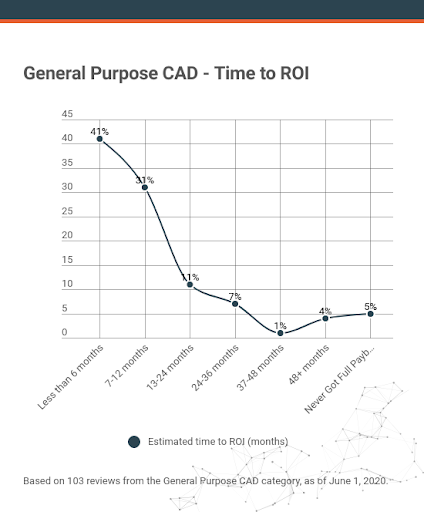
| Ease of Use (minimum 7) | Meets Requirements (minimum 7) | Return on Investment (ROI) within 6 months |
| 56% Cloud | 70% Cloud | 45% On-premise |
| 39% On-premise | 43% On-premise | 41% Cloud |
How quickly do users implement their CAD systems?
How quickly it takes to implement a software is particularly important for a system that might be as pricey as CAD software. Users want to get their systems up and running to make use of the software as quickly as they can. In this regard, users implement their CAD systems at a rapid pace which is advantageous to general-purpose CAD users:
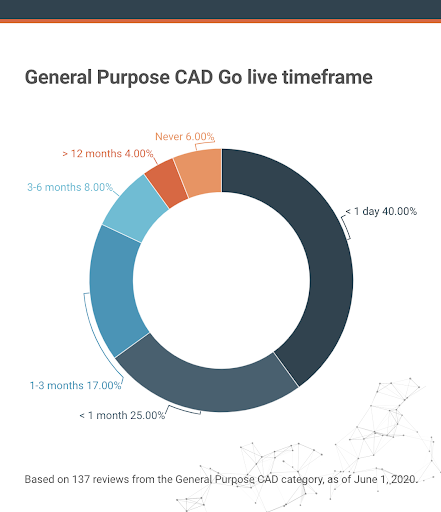
The data above illustrates that 40% of all CAD users implement their CAD system in less than a day. Additionally, 65% of all general-purpose CAD users say that they implemented their system in less than a month. These rapid implementation times are extremely beneficial for users.
CAD is being used in more vertical industries
Historically, CAD had been exclusively used by civil engineers, architects, and manufacturers. These industries craved the precision and detail that came along with computer-aided design software. This was primarily because it provided them with a dynamic analysis of their structural designs as well as the ability to place their designs into 3D environments.
Using G2 review data we were able to see some of the industries represented in the General-Purpose CAD category from August 2012 until January 2015.
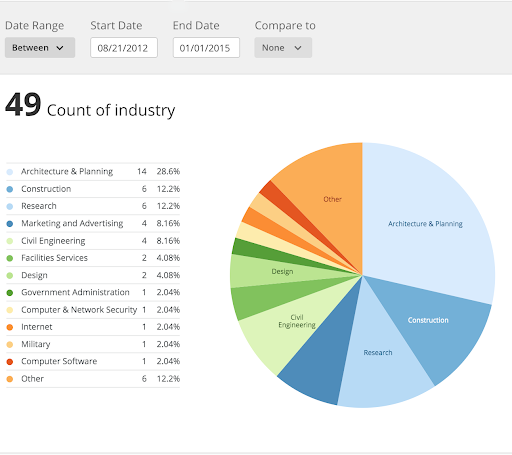
The data reveals that the software was mostly utilized in architecture, construction, and civil engineering. While there were some users in other industries, the data shows that these industries are scattered and few and far between.
Analyzing the data between 2015 and today paints a very different story, however. Looking at the data below, it can be inferred that “other” industries have taken over as the main industry segment that’s represented in the general-purpose CAD software, accounting for almost one third of all reviewers that come to the General-Purpose CAD category. Additionally, there are an astonishing 103 different industries represented in the entirety of the General-Purpose CAD category.
.png)
A deeper look into the data reveals the variety of industries that are represented within the “other” industries segment. From real estate to renewable energy and environment, there are 93 different industries represented within this segment alone.
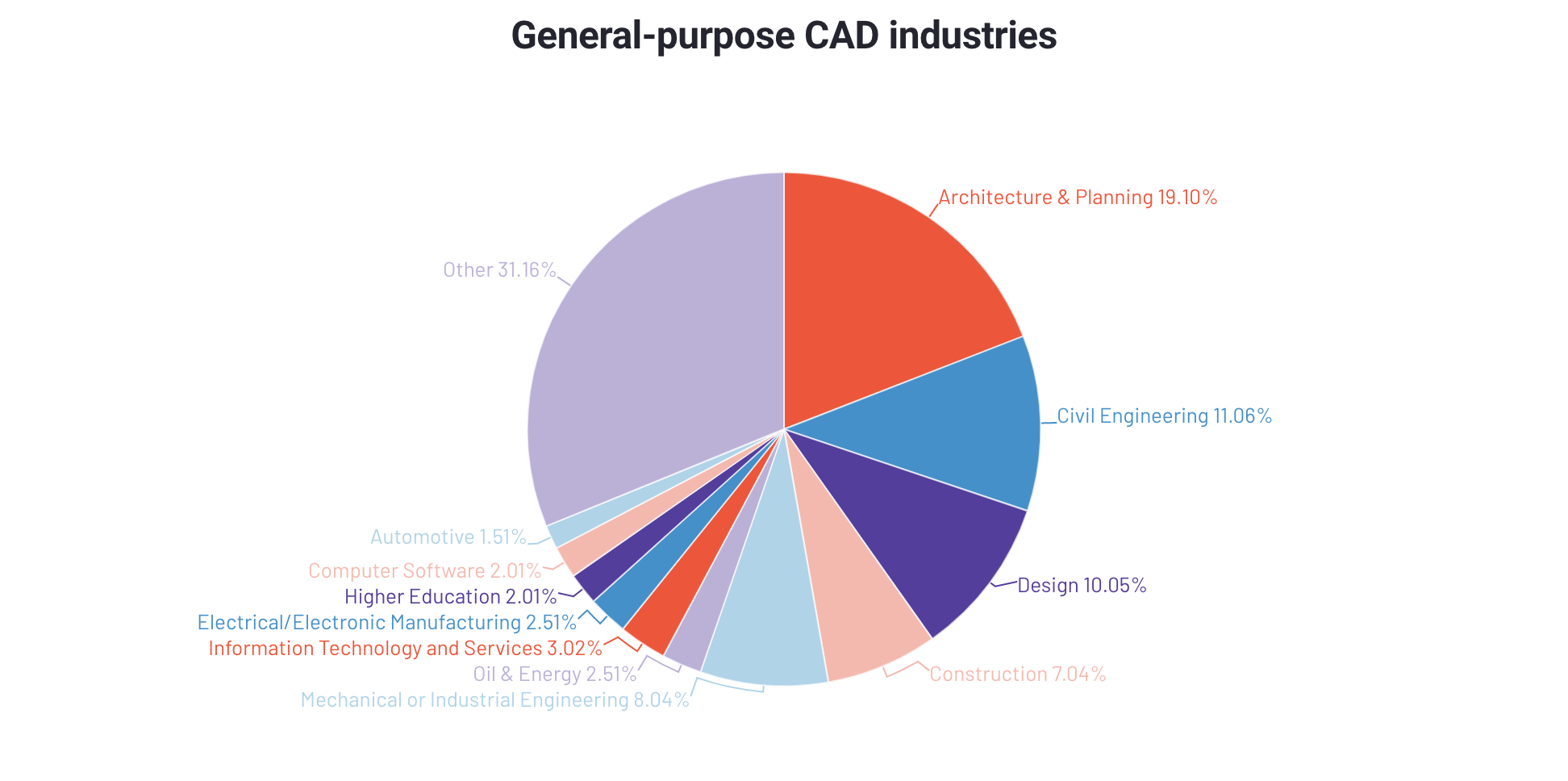
.png) This data points to a larger trend that is happening within the CAD landscape. Industries are realizing the dynamic use cases of this software and using it to their advantage. From fashion to the automotive industry, CAD is allowing an increasing number of users to rapidly design 3D prototypes, saving time and improving accuracy, precision, and control in drafting and design.
This data points to a larger trend that is happening within the CAD landscape. Industries are realizing the dynamic use cases of this software and using it to their advantage. From fashion to the automotive industry, CAD is allowing an increasing number of users to rapidly design 3D prototypes, saving time and improving accuracy, precision, and control in drafting and design.
Over the coming years, a growing number of specialized CAD vendors are expected to emerge and offer solutions that are geared for specific verticals.
| Read More: 2020 Trends for Computer-Aided Design (CAD) → |
Latest developments
Since CAD tools have been around for decades, the market is very mature, which also means that there are few major developments disrupting it. That doesn’t mean that CAD tools aren’t evolving. On the contrary, many CAD providers announced product enhancements, partnerships, and other improvements to their offerings.
| The 2019 CAD news can be grouped in a few categories: |
|
Some of the most relevant news for each category are summarized below:
Industry-specific enhancements
While there are many industry-specific CAD solutions such as computer-aided manufacturing (CAM), the vendors focusing on general-purpose CAD also develop functionality or solutions for industries such as construction and architecture. Some of the most important industry-specific enhancements announced in 2019 by general-purpose CAD vendors were:
- TurboCAD 2019 delivered new features for architecture and construction
- nanoCAD released new versions of its solutions for construction and mechanical engineering: nanoCAD Construction 9.0 and nanoCAD Mechanica 9.0
- Cortona3D partnered with Flatirons Solutions to improve aircraft maintenance by making it more interactive
New technologies such as AR and 3D printing
The manufacturing industry is changing through the adoption of technologies like additive manufacturing (3D printing) used to quickly create spare parts and components, and augmented reality (AR), which helps improve the product development process. To keep up with these changes, CAD vendors announced new AR and 3D printing features in 2019, the most important being:
- The new PTC Creo 6.0 includes features for AR, such as support for HoloLens and 3D printing
- Siemens Solid Edge 2020 delivered new AR capabilities to help users with simulation validation
Online catalogs for parts and CAD models
Instead of designing and managing CAD models, companies may choose to use CAD libraries where they can find 2D and 3D CAD files ready to use. These files can be used for 3D printing, in manufacturing, or as a starting point for more advanced models. CAD libraries and catalogs aren’t replacing but complementing general-purpose CAD software. In 2019, several companies launched online catalogs for CAD and BIM models, such as iCONN Systems and Monkeytoe. Also, TraceParts announced APIs which allow companies to display CAD models and data on their websites.
Partnerships and integrations
The adage “if you can’t beat them, join them” applies to the CAD world for several reasons: CAD is by definition collaborative which means that competitors often partner to provide better features. Smaller vendors don’t have huge R&D budgets so they prefer to deliver new features through integration. Some of the most important partnerships announced in 2019 were:
- AutoCAD partnered with Microsoft and Box to help users store and manage CAD files in Microsoft OneDrive and Box; Autodesk already provides integration with Dropbox and SharePoint and the new partnership offers more options to store CAD data
- Arena Solutions announced a strategic partnership with Acumatica which provides better integration between Arena’s PLM and QMS software and Acumatica’s ERP product
Learning portals for CAD users
Despite improvements, CAD software is still difficult to learn. Also, CAD users need to keep up to date with the latest features, which isn’t easy without training. Technologies like cloud and mobile make it easier for users to learn CAD through access to a multitude of content delivered in multiple formats (video, text, interactive, and so on). CAD vendors released new learning offerings in 2019, such as Vectorworks University, or collaborated with learning providers like Coursera to deliver online training.
New ways to buy CAD software
Traditional CAD software has been delivered on-premises and the cloud delivery model isn’t yet provided by all vendors. To transition from on-premises to the cloud, an increasing number of vendors now offer both options. A few examples from 2019 are:
- SketchUp introduced a new subscription model and three plans for professional users: Shop (web only), Pro and Studio (available on the web and as a desktop product)
- AutoCAD 2019 provides subscribers with access to seven separate tools, traditionally delivered independently by Autodesk
- Siemens Digital Industries Software announced the availability of Simcenter 3D software and Simcenter Amesim as a software as a service (SaaS) delivery model
- PTC acquired Onshape, a cloud-native CAD software provider, to increase its recurring revenue and better serve the SMB market
All these releases, partnerships, and collaboration projects make the CAD market more open and diverse by providing new options to designers and engineers. For instance, CAD users can now choose between buying or renting software, or find models using CAD libraries. Once the CAD model is finalized, there is the option to manufacture it internally, 3D print it, or outsource production.
|
Read more CAD predictions such as generative design, heavier cloud adoption, and VR CAD, here: |
What’s next for CAD
An analysis of 2999 reviews from 2015 to 2020 shows an increase in satisfaction with CAD systems. As shown below, CAD reviewers gave mostly maximum scores for “meets requirements” in all years, with the exception of 2016. The percentage of maximum scores increased from 33% in 2015 to 60% in 2020.
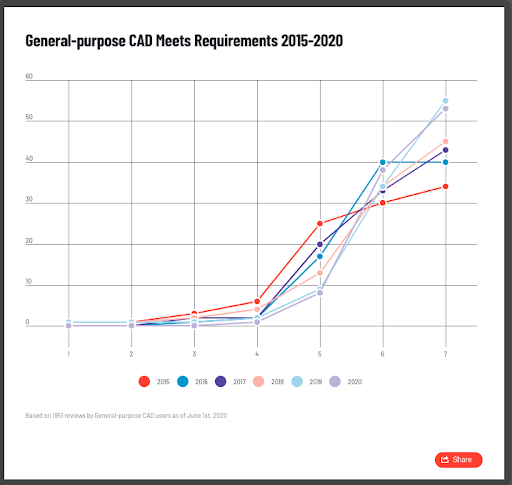
As vendors continue to focus on improving their products, providing new delivery models, and collaborating to complement each other’s offerings, we expect the satisfaction levels to maintain the upward trend.
At the same time, general-purpose CAD software will become more specialized as vendors choose to focus on industries or market segments that are more profitable for them. Ideally, vendors should provide industry-agnostic CAD and specialized versions, but this requires investment in product development or mergers and acquisitions.
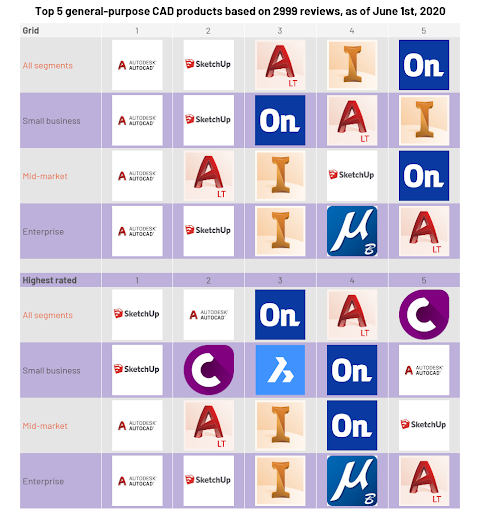
Since only large vendors can afford this type of investment, we predict that the general-purpose CAD market will be dominated by a few vendors. Our review data shows that the highest performing general-purpose CAD products are provided by only four vendors.
Want to learn more about Product Lifecycle Management (PLM) Software? Explore Product Lifecycle Management (PLM) products.

Michael Gigante
Mike is a former market research analyst focusing on CAD, PLM, and supply chain software. Since joining G2 in October 2018, Mike has grounded his work in the industrial and architectural design space by gaining market knowledge in building information modeling, computer-aided engineering and manufacturing, and product and machine design. Mike leverages his knowledge of the CAD market to accurately represent the space for buyers, build out new software categories on G2, and provide consumers with data-driven content and research. Mike is a Chicago native. In his spare time he enjoys going to improv shows, watching sports, and reading Wikipedia pages on virtually any subject.
